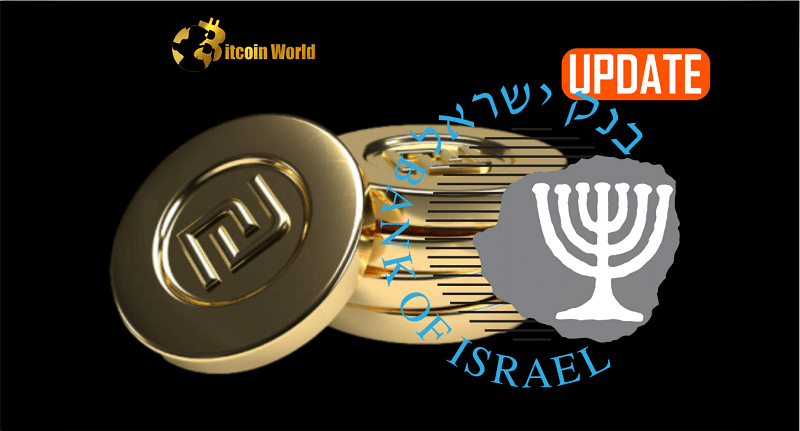The world of finance is constantly evolving, and the concept of digital currencies is no longer a futuristic fantasy. Even in the biblically significant region of Israel, the gears are turning towards a potential digital future for its currency. But what’s driving this shift, and what could a ‘digital shekel’ really mean? Let’s dive in.
Why is Israel Considering a Digital Shekel?
According to a recent paper from the Bank of Israel, the idea of a central bank digital currency (CBDC) – essentially a digital form of a nation’s fiat money – is gaining serious traction. Think of it as a digital version of the cash in your wallet, backed by the government. But why now?
- Following Global Trends: Israel is closely watching what other major players like the United States and the European Union are doing. If these economic giants decide to launch their own CBDCs, it would significantly increase the likelihood of Israel following suit.
- The Decline of Cash: While cash is still used in Israel, the trend is heading downwards. As people become more comfortable with digital payment methods, the need for a state-backed digital alternative grows.
- The Rise of Stablecoins: The increasing popularity of stablecoins, cryptocurrencies pegged to a stable asset like fiat currency, highlights the demand for digital payment solutions. CBDCs could offer a similar, but government-regulated, alternative.
What are CBDCs and How Do They Relate to Stablecoins?
You might be wondering, what exactly is a CBDC, and how is it different from a stablecoin? Here’s a simplified breakdown:
| Feature | CBDC (Central Bank Digital Currency) | Stablecoin |
|---|---|---|
| Issuer | Central Bank (Government-backed) | Private entities |
| Regulation | Government-regulated | Varying levels of regulation |
| Value Stability | Tied to the national fiat currency | Pegged to a reference asset (e.g., fiat currency, commodities) |
| Purpose | Digital form of national currency, potentially for retail and wholesale use | Often used for trading, lending, and cross-border payments |
While both aim to provide digital value transfer, CBDCs have the backing and stability of a central bank, while stablecoins rely on the reserves and mechanisms of their private issuers.
What are the Potential Benefits of a Digital Shekel?
A digital shekel could bring several advantages to the Israeli economy and its citizens:
- Faster Transactions: Digital payments are generally quicker than traditional methods.
- Lower Costs: Reduced transaction fees compared to some existing payment systems.
- Enhanced Security: Utilizing secure digital technologies can minimize fraud.
- Financial Inclusion: Could provide easier access to financial services for those currently underserved.
- Meeting Modern Demands: Caters to the growing preference for electronic payment options.
What Challenges Need to be Addressed?
The journey to a digital shekel isn’t without its hurdles. The Bank of Israel is carefully considering several potential challenges:
- Monetary Stability: Ensuring the introduction of a CBDC doesn’t disrupt the overall stability of the financial system.
- Privacy Concerns: Balancing the need for transparency with the public’s right to privacy in financial transactions.
- Cybersecurity Risks: Protecting the digital currency infrastructure from cyberattacks.
Following in the Footsteps of Others?
Israel isn’t alone in exploring CBDCs. As Ilan Tennenbaum, an analyst, points out, countries like Australia, Brazil, Canada, China, India, and Japan are already at various stages of CBDC development. The Bank of Israel is actively monitoring these projects to learn from their experiences and challenges.
Interestingly, the Bank of Israel has been actively involved in exploring the potential of digital currencies. They previously collaborated with the Bank for International Settlements (BIS) and the central banks of Sweden and Norway on “Project Icebreaker.” This initiative specifically investigated the use of CBDCs for cross-border retail payments and remittances – highlighting the potential for faster and cheaper international money transfers.

What’s Next for the Digital Shekel?
The Bank of Israel’s Steering Committee has identified key triggers that could push them towards issuing a digital shekel. These include the adoption of CBDCs by major economies and the continued decline in cash usage within Israel.
Furthermore, Israel’s regulatory landscape for digital assets is evolving. The Israel Securities Authority (ISA) has proposed regulations that would treat digital assets similarly to traditional securities like stocks and bonds. This indicates a growing acceptance and formalization of the digital asset space within the country.
Key Takeaways:
- Israel is seriously considering launching a digital shekel, a central bank digital currency (CBDC).
- The decision is influenced by global trends, particularly the actions of the US and EU, and the decreasing use of cash.
- CBDCs offer potential benefits like faster transactions and lower costs but also present challenges related to privacy and security.
- Israel is actively learning from other countries’ CBDC projects and has participated in cross-border payment initiatives.
- The future of the digital shekel depends on various factors, including technological advancements and regulatory developments.
The Future is Digital?
The exploration of a digital shekel signals a significant step for Israel in adapting to the evolving financial landscape. While challenges remain, the potential benefits of a secure, efficient, and state-backed digital currency are compelling. Whether Israel will ultimately launch its own CBDC remains to be seen, but the groundwork is being laid, and the conversation is well underway. Keep an eye on this space – the digital future of the shekel could be closer than you think!
Disclaimer: The information provided is not trading advice, Bitcoinworld.co.in holds no liability for any investments made based on the information provided on this page. We strongly recommend independent research and/or consultation with a qualified professional before making any investment decisions.


